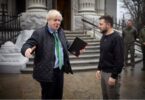Sylvan Lane
The Federal Reserve and the stock market are butting he-ads over the central ban-k’s efforts to fight inflation.
Stocks capped a steep two-day sell-off on Friday, wiping out gains from a rally earlier in the week driven by hopeful economic news. Inflation as measured by the consumer price index had fallen for the fifth straight month — and far more than analysts expected — according to data released right before the Fed was set to slow down its interest rate hikes.
While the Fed did end up boosting rates by a smaller amount than its previous four hikes, a dour forecast from officials, including Chairman Jerome Powell, shook markets out of their optimism. Instead of signs of lower interest rates ahead, the Fed warned rates would be even higher and stay that way for longer.
The Dow Jones Indu-strial Average closed down 281 points Friday, falling 0.9 percent on the day for its second straight week of losses. The S&P 500 index closed 1.1 percent lower, and the Nasdaq closed with a loss of 1 percent on the day, respectively.
“The Fed and the stock market are fighting. They’re in a brawl right now,” said Callie Cox, U.S. investment analyst at online investment firm eToro, in a Friday phone interview.
“The stock market’s been itching for a pivot for mo-nths now, really since the summer, and the Fed time and time again has told us that they’re serious about inflation, they want to get inflation under control, and if that means keeping rates high for a while, so be it,” she added.
As interest rates continue to rise, businesses will face steeper borrowing costs and have less money to invest in expansion, making their stocks less appealing to investors. Households will also have less expendable income to throw in the market as interest rates on their mortgages, car payments and credit cards rise.
The stock market’s hardship, however, is an important part of the Fed’s plan.
Fed officials know their tough talk about keeping rates high and snuffing out inflation at whatever the cost alarms investors and traders. Those warnings are intended to keep Americans’ expectations in check and force businesses to feel the squeeze of high rates without rising stock prices to buffet the blow.
“The Fed knows that its words are equally as powerful in a world where social media is so pervasive and information just moves so quickly,” Cox said. “The Fed is preparing markets for what’s coming before it actually happens. This time around, though, it just feels a little bit more painful because the Fed needs to get inflation down.”
Powell said during a Wednesday press conference that the U.S. still had “a long ways to go” before inflation was down to a sustainable level. He added th-at the only way for the Fed to achieve that goal was to keep its foot on the brakes of the economy with high interest rates meant to boost the unemployment rate.
The November jobless rate of 3.7 percent is just 0.2 percentage point below its level in February 2020, then a five-decade record low. But the U.S. workforce has roughly 4 million fewer workers now than it did before the onset of the pandemic, while businesses are posting record numbers of open jobs. With fewer workers available to fill open jobs, businesses have been forced to boost wages to attract candidates — and prices to compensate for that higher pay. That dynamic, Fed officials say, is the reason why inflation has remained high even as prices for almost all goods other than food have fallen.
“We have too many jobs and too few workers, so that means that wage inflation is going to be far from a sustainable average, and we’re going to have that passing through to prices. That’s w-hat we’re working on right now,” said Mary Daly, president of the Federal Reserve of San Francisco, at a Frid-ay event hosted by the Am-erican Enterprise Institute.
“To be honest with you, I don’t quite know why markets are so optimistic about inflation,” Daly said.
On Wednesday, Fed officials boosted their projections for how high they would need to raise interest rates and how long they would keep them at levels meant to hinder the labor market. They now expect to hike interest rates to a span of 5 to 5.25 percent by the end of 2023, up from the 4.5 to 4.75 range officials projected in September, and they don’t foresee cutting rates until 2024.
The Fed also sees its rate hikes taking a serious toll on the U.S. economy, projecting the jobless rate to increase by 0.9 percentage points to 4.6 percent by the end of 2023 and economic growth slowing to 0.5 percent. While Fed officials say it may be possible to avoid heavy job losses in that scenario, most outside economists believe such an increase in the jobless rate would mean more than 1 million Americans losing work. “The Fed did not welcome the disinflation trends that have just started to emerge and focused on robust job gains and elevated inflation. Any hopes of a soft landing disappeared as the Fed seems like they are committed to taking rates much higher,” said Edward Moya, senior markets analyst at OANDA, in a Wednesday note to clients.
A Fed-driven recession or steep slowdown would b-e more bad news for the stock market as companies struggle with lower sales and fewer households have the flexibility to put money in risky assets. But higher rates in and of themselves could be a larger and long-er-term damper on the stock market. Stocks exploded in value in the years following the Great Recession as the Fed kept its baseline interest rate range near zero. The market’s stunning rally accelerated even more during the COVID-19 pandemic, when low interest rates and trillions of dollars in federal stimulus helped fuel new records across all three major indexes.
With rates likely to stay high for much longer, Cox said the days of the market smashing through record highs again are likely far away. “When we look at 2023, we kind of see a year of purgatory,” she said.







